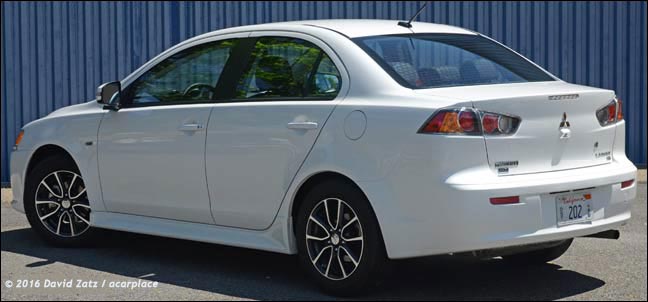
2016 Mitsubishi Lancer: Fun, practical throwback The Mitsubishi Lancer has a lot of high tech under the hood, but it also brings some of what we’ve been missing in the race for “refinement” and noise reduction. It has a relatively simple interior, comfortable seats, sporty ride, and good responsiveness; but it also has 1990s-style road noise and a good deal of wind noise at highway speeds.
Our test car had the all wheel drive system, unusual at such low prices ($22,830, but even the base ES has an AWD option). The all-drive Lancers have a 168 horsepower four-cylinder, though the base front wheel car has a smaller 2.0 liter engine (the 2.4 is still optional there).

The CVT never takes the 2.4 engine past its peak power, so you never feel it lag as you go up to redline; it also never takes it up to the redline, stopping somewhere between 5,000 and 5,500 rpm in our experience (it varied). It’s not the fastest car in its class, but it’s confident under full acceleration at any speed, and you don’t have to worry about having acceleration suddenly slacken for a gear change.
The CVT normally acts somewhat like emulate a traditional automatic, though it is continuously variable, using belts instead of gears. It lets the engine change its speed more than early CVTs did, sacrificing some economy in favor of natural reactions. It was much faster to react than most cars; there is no frustrating delay between pedal and response, and the engine was good enough to give us a sensation of acceleration even after it steadied out at, say, 5,400 rpm. 0-60 times were good for the price.

The low-slug car had good handling, with a light touch from the stability control. The ride was firm but not stiff; you felt the jiggles and bumps, but the car didn’t seem to go out of its way to find new road imperfections, as some do, and many of the annoyances were filtered out decently enough. It’s not as “refined” as some cars, but some of us like the sportier feel.

The manually adjusted front seats were more comfortable to me than the ones in most cars. Some modern-car annoyances (hard seats and intrusive headrests) were pleasantly missing. The sun visors were skimpy, but visibility was good otherwise. Getting into the back was easy enough, and the back seats were also comfortable albeit with relatively little headroom.
The Lancer’s long legroom — an inch more than the Dodge Dart, half an inch more than the Mazda3 — helps when carrying four people.
Both gauges and graphics were clear and readable gauges, despite excessive range (150 mph on the speedometer and 8,000 rpm on the tachometer); the resolution of the fuel gauge was good enough, and the bar was wide enough for instant reads. The trip computer gave the usual information: distance to empty (shown below), average mileage, average speed, and the time — including months or weeks — to the next maintenance. Some settings can be changed by using a single button with short or long presses. Audio control, cruise, and voice control buttons sit on the steering wheel.

The air conditioner was on the weak side but the climate controls were easy and pleasant to use.
The Mitsubishi stereo (actually made by Mitsubishi, that is) has two tiny knobs and a touch screen with uninspired but functional software. The sound was excellent while the car was at rest or moving slowly on smooth blacktop, though some equalizer settings made some music sound odd. Our high-capacity music USB drive, the one we use on all cars with (usually) few problems, turned out to be too large. We set up a new one with around 12 albums and it worked well enough.
The Bluetooth phone system leaves most controls to the phone itself, only adjusting volume and song up/down, and the latter only worked sporadically, so USB probably is the way to go. Fortunately, the voice control worked very well.

Oddly, the folder listing on the USB drive was grayed for safety. You can’t use the system to set overall car preferences.
On the down side, seat adjustments are all manual; the engine is loud and there is a lot of road and wind noise, so the stereo’s great-when-parked sound degrades at highway speeds, as key frequencies are combatted by a great deal of road noise and a decent amount (over 65 mph) of wind noise.
Despite its relatively low price of $22,830 (the base FWD model is $18,430), the Mitsubishi Lancer SEL comes well-equipped. It includes heated, power side-view mirrors with turn signals; rain-sensing wipers; a spare; heated front seats; perforated leather surfaces; filtered air; rear heat ducts; tilt wheel; floor mats; the 6.1 inch, 140 watt six-speaker satellite stereo; rear camera; side curtain airbags and front seat mounted airbags; and accommodations for a roof carrier, among other things. Our test car had no options, which let us judge it better; you can get insanely powerful stereos, navigation, and other options if you want.

Mitsubishi’s warranty is generous indeed: 10 years or 100,000 miles on the powertrain, five years of roadside assistance, and five years or 60,000 miles of bumper to bumper.
We liked the Lancer’s back to basics approach, with technology working for us rather than being in our face. The Dodge Dart is more refined, the Mazda3 is more economical (or, if you use the 2.5 engine, faster), and both have better sound insulation; but with all wheel drive, and the only serious sedan competitor is the Subaru Impreza, which starts at $19,090 ($20,090 with a CVT). The Lancer is a good deal for AWD buyers, and fun for people who feel something missing from other new compacts and midsize cars.
| 2016 | Mitsu Lancer SEL AWD |
|---|---|
| Price, as tested | $22,830 |
| Price, base | $18,430 |
| Weight | 3,142 |
| Horsepower | 168 |
| Torque | 167 |
| Cabin volume | 93.5 |
| Trunk | 12.3 |
| Legroom (front+rear) | 78.4 |
| Shoulder room | 54.7/54.3 |
| MPG | 23/31 |

David Zatz has been writing about cars and trucks since the early 1990s, including books on the Dodge Viper, classic Jeeps, and Chrysler minivans. He also writes on organizational development and business at toolpack.com and covers Mac statistics software at macstats.org. David has been quoted by the New York Times, the Daily Telegraph, the Detroit News, and USA Today.
